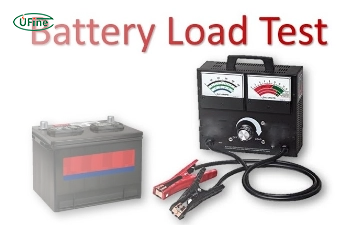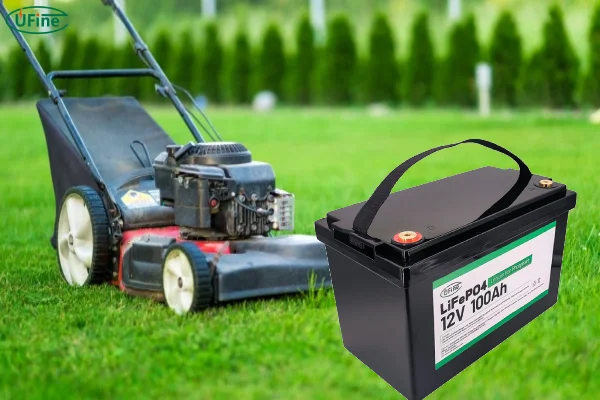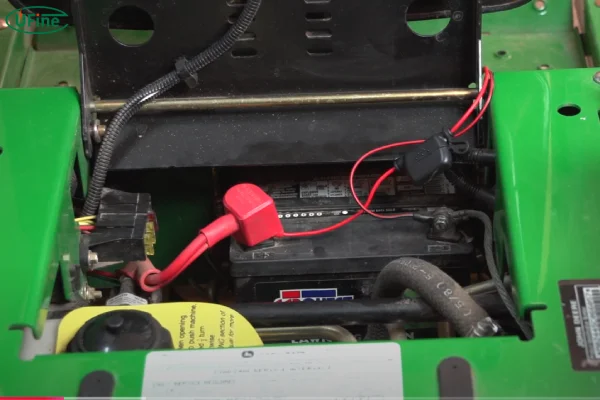
- Part 1. Understanding the basics of a 12V mower battery
- Part 2. 12 Volt lawn mower battery types
- Part 3. How to charge a 12V lawn mower battery?
- Part 4. How long to charge a 12V lawn mower battery?
- Part 5. 12V lawn mower battery discharge tips
- Part 6. How to maximize battery life for lawn mower?
- Part 7. How to choose the 12V battery for a lawn mower?
- Part 8. How to choose the best 12V lawn mower battery charger?
- Part 9. Common issues and troubleshooting 12V mower battery
Part 1. Understanding the basics of a 12V mower battery
A 12v mower battery is the heart of an electric lawn mower. Because a 12V mower battery performs all the functions. Before we move towards the details of lawn mower battery 12v, we want you to know the basic terms used for batteries.
- Voltage (V): As you know, most batteries consist of 12 volts, which is standard. You will find a 12v riding lawn mower battery-operated, which is ideal for the small and medium garden of the house.
- Battery Capacity (Ah): These terms represent the capacity of battery ampere per hour. It is the indication of how long the battery is going to perform. So if a lawn mower battery 12v has higher Ah, meaning it is going to perform for longer.
- Cold Cranking Amps (CCA): It is a crucial battery rating. Cold-cranking amps indicate a 12v mower battery’s ability to deliver power in cold temperatures, as mowers often have to operate in chilly mornings.
Part 2. 12 Volt lawn mower battery types
When choosing a 12-volt lawn mower battery, it’s important to understand the different types available. Each type has its unique features, benefits, and applications:
-
Lead-Acid Batteries:
Lead-acid batteries, particularly sealed lead-acid (SLA) and flooded lead-acid (FLA), are the most common types found in 12V lawn mowers. SLA batteries are maintenance-free, whereas FLA batteries require periodic water refills. These batteries are affordable and reliable, making them ideal for most homeowners. -
Lithium-Ion Batteries:
Lithium-ion (LiFePO4 Battery) batteries are becoming increasingly popular for lawn mowers due to their lightweight, longer lifespan, and faster charging times. Though more expensive, they offer more power and last longer, making them ideal for frequent users. -
Gel Batteries:
Gel lead-acid batteries are a safer alternative to traditional lead-acid batteries. They are maintenance-free, resistant to vibrations, and perform well in extreme temperatures. However, they are typically more expensive than regular SLA batteries.
Graphite vs. Lead Acid vs. Lithium Batteries: Key Differences Explained
Part 3. How to charge a 12V lawn mower battery?
Charging your 12V lawn mower battery properly is crucial to ensure its longevity and performance. Here’s how to do it:
-
Turn off the Mower:
Ensure that the mower is turned off, and the battery is disconnected from the mower to prevent any accidental short circuits during charging. -
Check the Battery Type:
Before charging, check your battery’s type. If it’s lead-acid, lithium-ion, or gel, the charging procedure may vary slightly. Most modern chargers automatically detect the battery type. -
Use the Right Charger:
Select a charger specifically designed for 12V batteries. Many smart chargers are available that adjust the charging rate based on the battery’s condition. -
Connect the Charger:
Connect the charger’s positive clamp (usually marked red) to the positive terminal of the battery, and the negative clamp (usually marked black) to the negative terminal. Double-check the connections before proceeding. -
Set the Charger:
Set the charger to the correct voltage (12V) and amperage. For lead-acid batteries, charge at 2A to 4A; for lithium-ion batteries, follow the manufacturer’s instructions for amperage. -
Charging Time:
Plug the charger into a standard power outlet and start charging. Ensure that the charger is working properly. You may need to monitor the charging process, especially for lead-acid batteries that can overheat if charged too quickly.
Part 4. How long to charge a 12V lawn mower battery?
The time it takes to charge a 12V lawn mower battery depends on the battery type, size, and charger used:
-
Lead-Acid Batteries:
Typically, it takes 4 to 6 hours to fully charge a 12V lead-acid battery. However, it can vary based on the battery’s capacity (Ah) and the charger’s amperage. -
Lithium-Ion Batteries:
Lithium-ion batteries charge faster, generally taking around 1 to 2 hours for a full charge. Their efficiency and quick charging time are one of the reasons they are becoming increasingly popular in modern lawn mowers. -
Gel Batteries:
A gel battery usually takes about 5 to 8 hours to fully charge, depending on the charger and the battery size.
Remember, avoid overcharging the battery, as this can shorten its lifespan. Many modern chargers come with an automatic shut-off feature that stops charging when the battery is full.
Part 5. 12V lawn mower battery discharge tips
Properly managing the discharge of your 12V lawn mower battery is key to ensuring long-term performance. Here are some essential tips:
-
Avoid Deep Discharge:
Try not to let your battery go below 50% before recharging it. Deep discharges (below 20%) can significantly reduce the lifespan of your battery, especially for lead-acid and gel batteries. -
Charge Regularly:
Even if you’re not using your mower frequently, it’s important to charge the battery every 30 days to maintain its health. Lithium-ion batteries are less affected by this, but it’s still a good practice. -
Store in a Cool, Dry Place:
If you won’t be using your mower for an extended period, store the battery in a cool, dry place. Extreme temperatures, especially heat, can degrade the battery and lead to faster self-discharge. -
Avoid Overcharging:
Always use a charger with automatic shut-off features or a maintenance mode to avoid overcharging. Overcharging can cause the battery to overheat, damage the internal cells, and reduce its overall lifespan. -
Perform Regular Inspections:
Periodically inspect the battery for signs of damage, leaks, or corrosion. Keeping the battery terminals clean and ensuring the battery casing remains intact will improve performance and safety.
Part 6. How to maximize battery life for lawn mower?
There are some tips to improve the working capability and lifespan of an electric lawn mower or a riding lawn mower.
- Keep it Charged: Always charge the mower regularly. If it’s been sitting long, give it a full charge with a proper 12V charger.
- Don’t Deep Discharge: Avoid letting the battery completely die. Regularly mow to prevent your 12v mower battery.
- Store Smartly: During long storage periods in winter, disconnect the battery or fully charge it, and check and recharge every few months.
- Maintain Proper Connections: Cleaning any corrosion from battery terminals and ensuring tight connections for optimal charging can maximize battery life.
- Right Climate is Key: Avoid extreme heat or cold when storing and using your mower in temperatures that can lower the lawn mower battery from 12v to 10.2v.
- Use it Regularly: Regular use keeps the battery charged and healthy. Don’t let it sit unused for longer periods.
- Mind the Runtime: Don’t push your mower beyond its battery capacity. Therefore, mow in sections in case of having a larger lawn to avoid straining the battery.
Part 7. How to choose the 12V battery for a lawn mower?
When choosing a lawn mower or a riding mower that is 12v battery operated, always consider the following factors that count a lot. These factors are suitable battery types for lawn mowers, battery size, terminal position, amp hour, and battery voltage. As discussed above, most lawnmowers or riding mowers use a 12v battery. Therefore, if your lawn mower needs to replace an old battery with a newer one, you should check the mower specifications and previous battery details to choose accordingly. In case of buying a new lawn mower, always choose the mower with a 12v mower battery with higher amp hour and charging speed.
Part 8. How to choose the best 12V lawn mower battery charger?
Selecting the right charger for your 12V lawn mower battery is key to extending battery life and ensuring safe charging. Here are some important points to consider:
1. Battery Compatibility
Ensure the charger is designed for your battery type (e.g., lead-acid, lithium-ion, or gel). Using the wrong charger can damage the battery.
2. Correct Voltage and Amperage
The charger should match the 12V rating of your battery. Look for a charger with 2-4 amps for lead-acid batteries, and 1-2 amps for lithium-ion batteries. Too much amperage can overheat the battery.
3. Automatic Shut-Off
Choose a charger with an automatic shut-off feature. This prevents overcharging by stopping the charge once the battery is full.
4. Smart Charging
A charger with smart technology adjusts the charging process to maintain battery health and prevent damage.
5. Safety Features
Look for safety features like overcharge protection, overcurrent protection, and reverse polarity protection. These features ensure safe charging.
6. Durability
Choose a charger with a weather-resistant or rugged design for outdoor use, as lawn mower chargers need to handle the elements.
7. Charging Speed
If you need a quick charge, consider a fast charger. However, slower charging is gentler on the battery and helps extend its lifespan.
8. Brand and Price
Invest in a charger from a reputable brand like NOCO, Schumacher, or Battery Tender. While they may cost a little more, they offer reliable performance and safety.
Part 9. Common issues and troubleshooting 12V mower battery
When you are using an electric lawn mower, there are some issues you can face, specifically with the 12v mower battery.
1. Dead Battery
- Check connections for cleanliness and tightness.
- Test battery voltage should be around 12.6V fully charged.
- Charge the battery if unused for a long time.
- Consider replacing an older battery (2-4 year lifespan).
2. Slow Cranking
- Charge the battery for a full cycle.
- Clean and tighten battery terminal connections.
- Use a battery with a higher CCA rating for better cold starts (if applicable).
3. Mower Runs Erratically
- Loose and corroded battery terminals can cause the issue.
- Replace an older battery with a newer one if issues persist.
- Take the help of a technician for possible non-battery electrical issues.
4. General Tips
- Read the manual in case you have any issues with the machine.
- If you are dealing with the 12v mower battery, use eye protection glass for safety.
- Replace with a new 12V battery matching mower specs if troubleshooting fails.
- Dispose of old batteries at the recycling center.
Related Tags:
More Articles

Battery Load Test: A Comprehensive Guide
Step-by-step battery load test guide for car, solar & industrial use. Learn how to load test a battery, interpret voltage charts, and avoid common mistakes.
The Comprehensive Guide to Battery Balancing and Battery Balancer
Discover how battery balancers improve lithium battery performance, lifespan, and safety. Learn types, functions, and tips to choose the right balancer.
What Is the Best Voltage for a Chainsaw Battery?
Compare 12V-80V chainsaw batteries for light pruning, medium firewood, and professional cutting. See best battery chainsaw with runtime charts and safety tips.
Lithium VS. Alkaline Batteries: A Comprehensive Comparison
Lithium batteries last 3–7× longer than alkaline and perform better in cold weather. Compare lifespan, cost, safety, and best uses to choose the right battery.
Comparing Lithium-Sulfur and Lithium-Ion Batteries: Which is Right for You?
Compare lithium-sulfur (Li-S) and lithium-ion batteries on energy, lifespan, cost, safety, and applications. Best choice for drones, EVs, and electronics.




